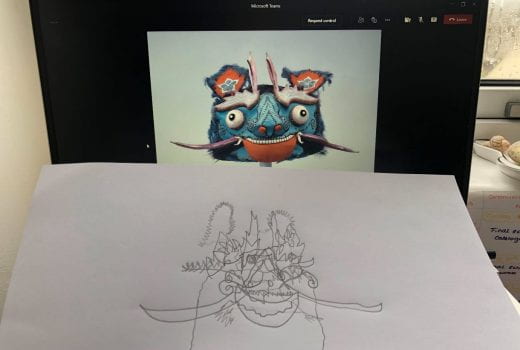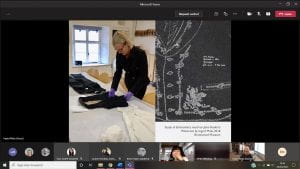Olivia Terry, Third Year BA (Hons) Fashion and Dress History student shares her research into nature and dark romanticism in the work of an artist and fashion designer.
Back in the spring of 2020, I was in the midst of writing my presentation for the second year module After Modernism: Postmodernism and Beyond, when university as we had known, changed. The pandemic seemed to have loomed in the background for so long, and then with breakneck suddenness, everything was moved online. Unfortunately, in all of the chaos of transition, I never got to share my research to my classmates, yet when I reflect back on my time at Brighton, I consider it to be my favourite presentation.

Fig. 1. Anna Dumitriu. The Romantic Disease Exhibition. Pictured: Where There’s Dust There is Danger, Rest! Rest! Rest! And Pneumothorax Machine. 2014. Waterman’s Gallery, London. Still from The Romantic Disease at Watermans. 2014. Vimeo. https://vimeo.com/93513389
I was assigned the topic of fashion and nature. Ironically, months prior to the pandemic taking over every aspect of our lives, I chose to focus on disease, when I read about a 2014 postmodern exhibit titled The Romantic Disease: An Artistic Investigation of Tuberculosis (see Fig.1). Anna Dumitriu, a British bio artist, combined science with art to create an exhibition that redefines the division between art and nature, by introducing disease to her collection. Textiles in the exhibit were literally impregnated with extracted DNA of sterile Mycobacterium tuberculosis. Centered around mankind’s relationship with the disease, Dumitriu simultaneously played scientist while creating an exhibition that inspired strong feelings of romanticism and horror, similar to that of postmodern fashion designer, Alexander McQueen. The artists differ in their approaches to communicating nature as a theme, but the end results are blaringly similar: nature is at the heart of beautiful suffering.
The exhibition featured a 19th century altered maternity dress known as the Romantic Disease Dress (see Fig. 2).

Fig.2. Anna Dumitriu. The Romantic Disease Dress. Victorian Maternity Dress stained with natural dyes. https://www.a-n.co.uk/media/5039835/
It had been stained with walnut husks and embroidered with madder root and prontosil dyed silk. Madder root dyed flowers decorate the neckline and safflower dyed bows were placed on the cuffs. Walnut husks, madder root and safflower, were once used as ancient remedies for tuberculosis. The dress is also stained with extracted DNA of killed TB. Dumitriu chose the maternity dress because TB was once thought to be genetic, so infected individuals were discouraged from marrying, and in some cases, pregnant women with TB were given forced abortions. The dress combines fact and feeling, making it a powerful piece. It uses historical remedies and strains of TB, while representing the emotional toll and extreme loss of the disease.
Similar to Dumitriu, Alexander McQueen dramatizes the killer side of nature, while still communicating beauty. His Oyster Dress (click to see an image) brilliantly combines nature and romanticism: Originating from the 2003 “Irere” collection, the dress seems to be a “poetic rendering of a disaster at sea.” (Met Museum) A layered sand coloured silk organza resembles the curved lip of a mollusk, and tossed over the shoulder, is reminiscent of a shredded fishing net. The dress and mannequin both invoke dramatic feelings surrounding a tragic disaster at sea.
Both Dumitriu and McQueen’s work stem from nature. While Dumitriu chose to explore nature at its most microscopic level, her exhibits share similar postmodern elements such as unconventional materials, nostalgia, romanticism, and horror as McQueen. While their creative approaches differ dramatically, both create highly emotional art that communicates the cut-throat beauty of nature.




